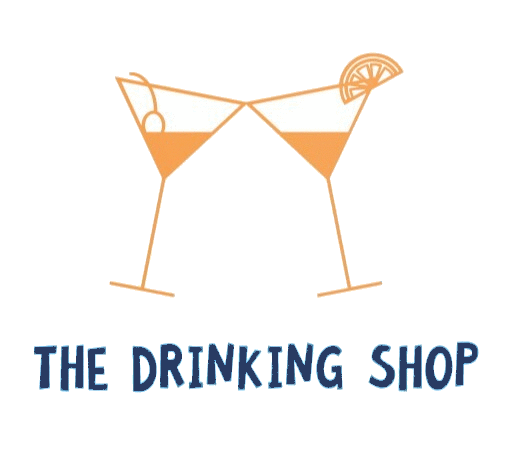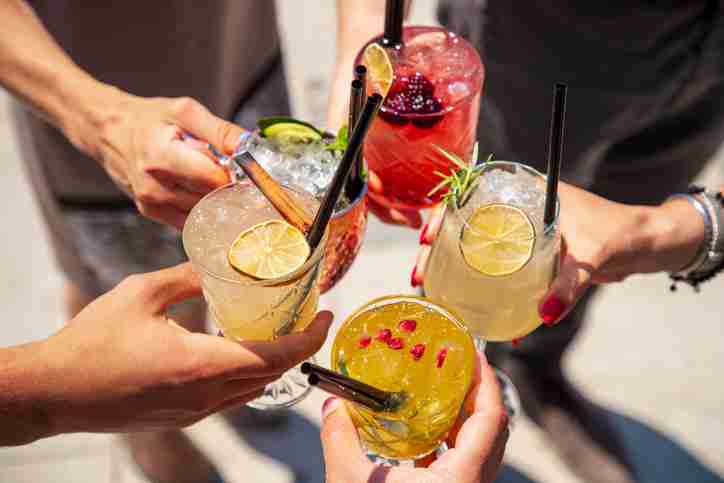Whether you are a newbie, wannabe or a connoisseur, as long as you love your drink, or have buddies who do (else why would you be here?), it is always useful to know a bit about your/ their favorite drinks. So here is a list of some drinking words and what they mean – use it to impress your buddies, test your knowledge, or just to know what you’re drinking- but most of all, have fun with it!
|
Aeration: |
The process of exposing wine to
air, allowing it to "breathe" and release its aromas. |
|
Agricole: |
A style of rum made from fresh sugarcane
juice rather than molasses, often produced in the French Caribbean. |
|
Ale: |
A type of beer brewed using a
warm fermentation method, resulting in a wide range of flavors
and styles. |
|
Amaro: |
An Italian herbal liqueur often
consumed as a digestif, characterized by its bitter-sweet flavor
profile. |
|
Americano: |
A classic cocktail made with
Campari, sweet vermouth, and soda water. |
|
Amontillado: |
A type of sherry that has been
aged under a layer of yeast (flor) and then
oxidatively, resulting in a nutty, amber-colored
wine. |
|
Añejo: |
A term used to describe aged
tequila or rum, typically indicating a minimum aging period of one year. |
|
Angel’s Share: |
The portion of a distilled spirit
that evaporates during the aging process, typically accounting for a 2-3%
loss per year. |
|
Aperitif: |
A light, alcoholic drink served
before a meal to stimulate the appetite. |
|
Appellation: |
A legally defined and protected
geographical area used to identify where grapes for a wine are grown. |
|
Armagnac: |
A type of brandy produced in
the Armagnac region of France, made from specific grape varieties and aged in
oak barrels. |
|
Astringency: |
A mouth-drying sensation caused
by tannins, often experienced when drinking wine or certain spirits. |
|
Back: |
A non-alcoholic beverage served
alongside a shot of liquor, intended to be sipped between sips of the spirit. |
|
Barleywine: |
A strong, full-bodied ale with
a high alcohol content and malt character, often aged for an extended period. |
|
Barrel Aging: |
The process of storing a
spirit, wine, or beer in wooden barrels to develop complex flavors and characteristics. |
|
Barrel Proof: |
A term used to describe a spirit
bottled directly from the barrel without dilution, resulting in a higher
alcohol content. |
|
Barrique: |
A French term for a small oak
barrel used for aging wine, typically with a capacity of 225 liters. |
|
Bartender: |
A person who mixes and serves
alcoholic drinks at a bar. |
|
Batonnage: |
A winemaking technique
involving stirring the lees (dead yeast cells) during aging to add richness
and complexity. |
|
Bière de Garde: |
A French farmhouse ale
traditionally brewed in the winter and spring, characterized by its
malt-forward profile and cellar-like flavors. |
|
Biodynamic: |
A holistic approach to farming,
which includes organic practices and considers the vineyard as an
interconnected ecosystem. |
|
Bitters: |
A concentrated, highly aromatic
liquid made from infusing herbs, spices, and other botanicals in alcohol,
used in small amounts to add complexity to cocktails. |
|
Blanc de Blancs: |
A Champagne or sparkling wine
made exclusively from white grapes, typically Chardonnay. |
|
Blanc de Noirs: |
A Champagne or sparkling wine
made exclusively from black grapes, typically Pinot Noir and/or Pinot
Meunier. |
|
Blanc: |
A term meaning
"white" in French, often used in the names of white wines or grape
varieties. |
|
Blend: |
A mixture of different grape
varieties, regions, or vintages to create a harmonious wine or spirit. |
|
Body: |
A term used to describe the
weight and mouthfeel of a drink, often wine or spirits. |
|
Bottle Aging: |
The process of allowing a wine
to mature in the bottle, enabling the development of complex flavors and aromas over time. |
|
Bourbon: |
An American whiskey primarily
made from corn and aged in new, charred oak barrels. |
|
Brandy: |
A distilled spirit made from
fermented fruit juice, most commonly grapes. |
|
Cabernet Sauvignon: |
A popular red grape variety
known for producing full-bodied wines with flavors
of black currant and bell pepper. |
|
Calvados: |
A French apple brandy produced
in the Calvados region of Normandy. |
|
Cask Strength: |
A term used to describe a
spirit bottled directly from the cask without dilution, resulting in a higher
alcohol content. |
|
Champagne: |
A sparkling wine produced
exclusively in the Champagne region of France, made primarily from
Chardonnay, Pinot Noir, and Pinot Meunier grapes. |
|
Chardonnay: |
A versatile white grape variety
used to produce a range of wine styles, from crisp and unoaked to rich and
buttery. |
|
Chartreuse: |
A French herbal liqueur made by
Carthusian monks, available in both green and yellow varieties. |
|
Chaser: |
A drink consumed immediately
after a shot of hard liquor, usually to mask the strong taste. |
|
Claret: |
A British term for a red
Bordeaux wine. |
|
Cocktail: |
A mixed drink typically
containing a spirit, mixer, and other flavorings. |
|
Cognac: |
A type of brandy produced in
the Cognac region of France, made from specific grape varieties and aged in
oak barrels. |
|
Collins: |
A family of cocktails made with
a base spirit, lemon juice, sugar, and soda water, served in a tall glass
with ice. |
|
Corkscrew: |
A tool used to remove corks
from wine bottles. |
|
Cuvée: |
A blend or batch of wine, often
used to describe a specific bottling or style. |
|
Decanter: |
A glass container used to
aerate and serve wine, allowing sediment to separate from the liquid. |
|
Demi-Sec: |
A term used to describe a wine
with a moderate level of sweetness, typically found in Champagne or sparkling
wine. |
|
Digestif: |
An alcoholic beverage consumed
after a meal to aid digestion, often rich and sweet in flavor. |
|
Dirty: |
A term used to describe a
cocktail, typically a martini, made with olive brine for a salty flavor. |
|
Distillation: |
The process of separating
alcohol from a liquid mixture by heating and cooling. |
|
Distillation: |
The process of separating and
concentrating the alcohol in a fermented liquid through heating and cooling. |
|
Dry: |
A descriptor for a wine or cocktail
with little to no residual sugar, often used to indicate a less sweet taste. |
|
Eau de Vie: |
A clear, colorless
fruit brandy produced by fermenting and distilling fruit juices. |
|
Eisbock: |
A strong, dark German lager created
by partially freezing the beer and removing the ice to concentrate the flavors and alcohol content. |
|
En Rama: |
A term used to describe
unfiltered and minimally treated sherry, bottled directly from the cask for a
fresher, more intense flavor. |
|
Fermentation: |
The chemical conversion of
sugars into alcohol by yeast. |
|
Fernet: |
A type of Italian amaro with a
bitter, herbal flavor profile, often consumed as a
digestif. |
|
Finings: |
Substances added to wine or
beer to help clarify and stabilize the liquid by removing suspended
particles. |
|
Fizz: |
A family of cocktails that
contain a base spirit, citrus juice, sugar, and soda water, served over ice. |
|
Flute: |
A tall, narrow glass used for serving
sparkling wine, designed to preserve carbonation and showcase the wine’s
bubbles. |
|
Fortified Wine: |
A wine that has had a spirit,
usually brandy, added during or after fermentation, resulting in a higher
alcohol content and distinctive flavor. |
|
Foudre: |
A large wooden barrel,
typically used for aging wine or beer, with a capacity ranging from 1,000 to
15,000 liters. |
|
Garnish: |
An edible decoration added to a
drink, such as fruit or herbs. |
|
Gimlet: |
A classic cocktail made with
gin or vodka, lime juice, and simple syrup. |
|
Gin: |
A distilled alcoholic beverage flavored with botanicals, including juniper berries. |
|
Gueuze: |
A Belgian sour beer made by
blending young and old Lambics, then allowing them to undergo a secondary
fermentation in the bottle. |
|
Highball: |
A type of cocktail served in a
tall glass, typically with a spirit, ice, and a non-alcoholic mixer. |
|
Hogshead: |
A large barrel used for aging wine
or spirits, typically with a capacity of 225-250 liters. |
|
Ice Bucket: |
A container used to keep ice
cubes or crushed ice cold and easily accessible for drink preparation. |
|
Irish Whiskey: |
A whiskey produced in Ireland,
typically made from a blend of malted and unmalted
barley and aged in wooden barrels for at least three years. |
|
Islay: |
A Scottish island known for its
distinctive peaty, smoky whiskies. |
|
Jigger: |
A measuring tool used by
bartenders to pour accurate amounts of liquid. |
|
Julep: |
A family of cocktails, most
famously the Mint Julep, made with a base spirit, sugar, and fresh mint,
served over crushed ice. |
|
Lager: |
A type of beer brewed at low
temperatures, usually light and crisp in flavor. |
|
Lambic: |
A Belgian sour beer
spontaneously fermented by wild yeast and bacteria, often aged in wooden
barrels and blended or flavored with fruit. |
|
Lees: |
The sediment, primarily consisting
of dead yeast cells, that settles at the bottom of a fermenting vessel during
winemaking or brewing. |
|
Legs: |
The rivulets of liquid that
cling to the sides of a glass after swirling, used to assess the alcohol
content and viscosity of a wine or spirit. |
|
Liqueur: |
A sweet, flavored
spirit, typically made by infusing or macerating fruits, herbs, or spices in
alcohol and adding sugar. |
|
Long Finish: |
A term used to describe a wine or
spirit with a lingering aftertaste, often indicative of high quality. |
|
Maceration: |
The process of soaking crushed
grapes, fruit, or other botanicals in a liquid to extract flavors,
colors, and tannins. |
|
Madeira: |
A fortified wine produced on
the island of Madeira, known for its distinctive oxidized character and high
acidity. |
|
Malolactic Fermentation: |
A secondary fermentation
process in winemaking that converts malic acid to softer lactic acid, often
used to reduce acidity and create a smoother, creamier mouthfeel. |
|
Malt: |
A grain, often barley, used in
brewing and distilling, which has been soaked, germinated, and dried. |
|
Manhattan: |
A classic cocktail made with
whiskey, sweet vermouth, and bitters. |
|
Marc: |
A French pomace brandy, similar to Italian grappa, made from the skins, seeds, and
stems left over from winemaking. |
|
Mash: |
The mixture of crushed grains
and hot water used in brewing or distilling to extract fermentable sugars. |
|
Mead: |
An alcoholic beverage made by
fermenting honey and water, often flavored with |
|
Merlot: |
A popular red grape variety
known for producing medium to full-bodied wines with flavors
of plum and black cherry. |
|
Methuselah: |
A large-format wine or
Champagne bottle with a capacity of six liters,
equivalent to eight standard bottles. |
|
Mezcal: |
A distilled alcoholic beverage
made from the agave plant, similar to tequila but
produced in different regions of Mexico and with a distinctive smoky flavor. |
|
Microbrewery: |
A small brewery that produces
limited quantities of beer, often with a focus on unique flavors
and artisanal techniques. |
|
Mixer: |
A non-alcoholic beverage used
to dilute and flavor a cocktail, such as soda or
fruit juice. |
|
Mojito: |
A classic Cuban cocktail made
with white rum, lime juice, sugar, mint, and soda water. |
|
Mulled Wine: |
A warm, spiced wine typically
made with red wine, sugar, and a blend of spices such as cinnamon, cloves,
and nutmeg. |
|
Neat: |
A term used to describe a spirit
served straight from the bottle without any mixers, ice, or water. |
|
Negroni: |
A classic Italian cocktail made
with gin, sweet vermouth, and Campari. |
|
Oaky: |
A flavor
descriptor often used for wines or spirits aged in oak barrels, referring to
the woody, vanilla, or spicy notes they can acquire. |
|
Oenology: |
The science and study of wine
and winemaking. |
|
Old Fashioned: |
A classic whiskey cocktail made
with sugar, bitters, and a citrus twist, served over ice. |
|
Oloroso: |
A type of sherry aged oxidatively,
resulting in a darker, nuttier wine with a higher alcohol content. |
|
Organic: |
A term used to describe wines
or spirits produced without the use of synthetic chemicals, such as
pesticides or herbicides. |
|
Oxidation: |
A chemical reaction that occurs
when wine or spirits are exposed to oxygen, often resulting in changes in color, flavor, and aroma. |
|
Pechuga: |
A type of mezcal distilled with
a raw chicken or turkey breast suspended in the still, imparting a savory, umami character to the spirit. |
|
Pét-Nat: |
Short for Pétillant Naturel, a
naturally sparkling wine made using the ancestral method, in which the wine
is bottled before the primary fermentation is complete. |
|
Pilsner: |
A type of pale lager beer,
characterized by its golden color, crisp flavor, and light body. |
|
Pinot Grigio: |
A popular white grape variety
known for producing light, crisp wines with citrus and green apple flavors. |
|
Pinot Noir: |
A red grape variety known for
producing elegant, medium-bodied wines with flavors
of red fruit and earth. |
|
Port: |
A fortified wine produced in
the Douro Valley of Portugal, typically sweet and often served as a dessert
wine. |
|
Proof: |
A measurement of the alcohol
content in a beverage, where the proof is double the percentage of alcohol by
volume (ABV). |
|
Quinquina: |
An aromatized wine fortified
with quinine, used as an aperitif or cocktail ingredient. |
|
Rancio: |
A term used to describe the unique,
nutty, and oxidized flavor profile that develops in
certain fortified wines and spirits as they age. |
|
Reposado: |
A term used to describe tequila
or rum that has been aged for a short period, typically between two months
and one year. |
|
Riesling: |
A white grape variety known for
producing aromatic wines with high acidity, ranging from bone-dry to sweet. |
|
Rosé: |
A type of wine made from red
grapes, but with minimal skin contact during fermentation, resulting in a
pinkish hue. |
|
Rum: |
A distilled alcoholic beverage
made from sugarcane byproducts, such as molasses,
or directly from sugarcane juice. |
|
Sake: |
A Japanese alcoholic beverage
made from fermented rice, typically served warm or chilled. |
|
Sangria: |
A popular Spanish drink made
with red wine, fruit, and sweeteners, typically served chilled. |
|
Sauvignon Blanc: |
A white grape variety known for
producing crisp, refreshing wines with flavors of
citrus, gooseberry, and grass. |
|
Sazerac: |
A classic New Orleans cocktail made
with rye whiskey, sugar, absinthe, and Peychaud’s bitters. |
|
Scotch: |
A whisky produced in Scotland,
typically made from malted barley and aged for a minimum of three years. |
|
Screw Cap: |
A type of closure used on wine
bottles as an alternative to traditional corks. |
|
Shaker: |
A container used by bartenders
to mix cocktails by shaking the ingredients together with ice. |
|
Sherry: |
A fortified wine produced in
the Jerez region of Spain, ranging from dry and crisp to sweet and nutty. |
|
Sidecar: |
A classic cocktail made with
cognac, orange liqueur, and lemon juice. |
|
Single Malt: |
A term used to describe a
whisky made from malted barley and produced at a single distillery. |
|
Solera: |
A system used for aging and blending
wines or spirits, in which younger liquids are gradually mixed with older
ones for consistency and complexity. |
|
Sommelier: |
A trained and knowledgeable
wine professional, often working in fine-dining establishments. |
|
Sour: |
A family of cocktails made with
a base spirit, citrus juice, and a sweetener, often including an egg white
for a frothy texture. |
|
Sparkling Wine: |
A wine with significant levels
of carbon dioxide, giving it a fizzy texture. Champagne is a famous example
of sparkling wine. |
|
Speyside: |
A region in Scotland known for
its whiskies, characterized by their fruity, floral, and often honeyed flavors. |
|
Split: |
A small-format wine or
Champagne bottle with a capacity of 187.5 milliliters,
equivalent to one-quarter of a standard bottle. |
|
Syrah/Shiraz: |
A red grape variety known for
producing bold, full-bodied wines with flavors of
black fruit, pepper, and spice. |
|
Tannins: |
A group of compounds found in
grape skins, seeds, and stems, which can give wine a dry, puckering sensation
in the mouth. |
|
Tequila: |
A distilled alcoholic beverage
made from the blue agave plant, primarily produced in the region around the
city of Tequila, Mexico. |
|
Terroir: |
The unique combination of
environmental factors, such as climate, soil, and topography, that influence
the flavor and character of a wine or spirit. |
|
Terroir: |
The unique combination of
factors, including soil, climate, and geography, that influence the flavor and characteristics of a wine. |
|
Tiki: |
A style of cocktail originating
in the mid-20th century, characterized by tropical flavors
and elaborate garnishes. |
|
Twist: |
A thin strip of citrus peel,
typically used as a garnish for cocktails. |
|
Varietal: |
A wine made primarily from a
single grape variety. |
|
Vermouth di Torino: |
A protected designation of
origin (PDO) for vermouth produced in the Piedmont region of Italy,
characterized by a specific set of production standards and ingredients. |
|
Vermouth: |
An aromatized, fortified wine flavored with various botanicals, used as an ingredient
in cocktails or served as an aperitif. |
|
Vermouth: |
An aromatized, fortified wine flavored with various botanicals, used as an ingredient
in cocktails or served as an aperitif. |
|
Vesper: |
A classic cocktail created by
Ian Fleming in the James Bond novel, Casino Royale, made with gin, vodka, and
Kina Lillet (or a substitute like Cocchi Americano). |
|
Vieux Carré: |
A classic New Orleans cocktail made
with rye whiskey, cognac, sweet vermouth, Benedictine, and bitters. |
|
Vintage: |
The year in which a wine’s
grapes were harvested. |
|
Vodka: |
A clear, distilled alcoholic
beverage originating from Russia and Poland, typically made from fermented
grains or potatoes. |
|
Whisky/ Whiskey: |
A distilled alcoholic beverage
made from fermented grain mash, aged in wooden barrels. The spelling varies
depending on the country of origin. |
|
Wine: |
An alcoholic beverage made from
fermented grape juice, typically categorized as red, white, or rosé. |
|
XO: |
A term used to describe cognac
or brandy that has been aged for a minimum of six years, indicating
"extra old." |
|
Zinfandel: |
A red grape variety, used to
produce bold, fruit-forward wines, as well as the popular blush wine called
White Zinfandel. |
Check out our handpicked collection of Bar Sets & tools to wow your friends!
Liked this? Share this with your friends now



